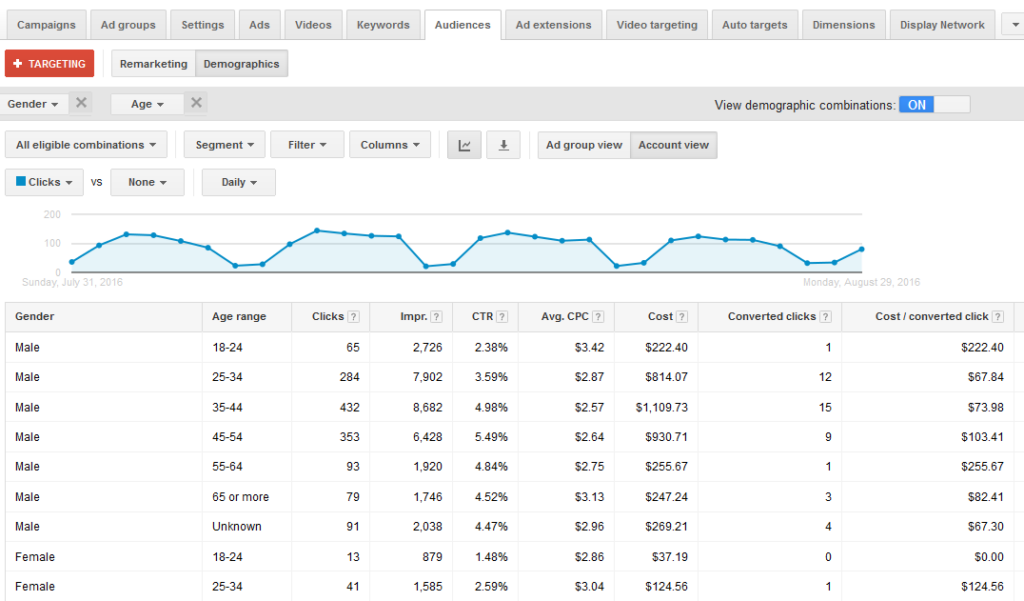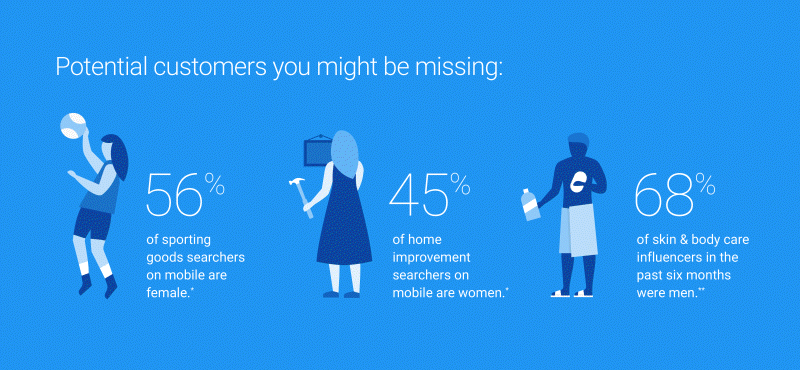While Google has provided advertisers with control over keyword match types and negative keywords to improve ad targeting, it can still be challenging to align user intent with their search queries. Advertisers often invest significant time in keyword research and analysis, but it’s important to remember that their audience consists of real people with diverse needs and preferences.
For instance, individuals of different ages, genders, and socioeconomic backgrounds may have distinct motivations when searching for products or services. A 19-year-old and a 70-year-old searching for “hair extensions” are likely seeking different outcomes, just as a man and a woman searching for “leather boots” may have specific preferences. Acknowledging user intent involves considering the characteristics and motivations of the users behind the search queries.
To address this, various online advertising platforms like Facebook and Bing have offered demographic targeting options. Now, Google AdWords has introduced the ability for advertisers to target specific age and gender demographics within their search campaigns.
These new demographic targeting options can be accessed at the ad group level in Google AdWords. The “Audiences” tab includes a new subtab called “Demographics,” which provides performance data for different age and gender segments within the ad group. Advertisers can leverage this information to adjust bids for specific demographics or exclude certain age groups or genders from seeing their ads on the search engine results page (SERP).

Similar to utilizing demographic targeting for display campaigns, advertisers now have the opportunity to gain deeper insights into the performance of layered demographic options within their search campaigns. By selecting “View demographic combinations,” advertisers can examine the performance of specific segments, such as women aged 25-34, to better understand their impact.
It’s worth noting that unlike the display network, search advertisers currently do not have the ability to directly target users based on their parental status. However, leveraging demographic combinations can still provide valuable data and insights to optimize search campaigns effectively.

Demographic Targeting for Search: Case Studies
While demographic targeting for search was in beta, a select group of Wordstream customers had the opportunity to test this feature in advance. The success stories from these early adopters highlight the effectiveness and versatility of search demographic targeting.
One notable example involves a plastic surgeon client who faced challenges with men’s interest in their search ads for breast enlargement treatments. Despite the majority of individuals searching for “larger breasts” being male, the target audience for such procedures tends to be women. With the introduction of AdWords’ demographic targeting, the plastic surgeon was able to exclude men from viewing their ads on the search engine results page (SERP). This simple adjustment resulted in a significant reduction in search costs and cost-per-acquisition (CPA), without compromising lead generation. In fact, the client was able to maintain their lead volume while achieving a 50% reduction in costs and CPAs.
One of our clients, a local florist, made an interesting observation about their website traffic. While the percentage of male visitors to their site was relatively small, they found that male visitors had a higher likelihood of converting and tended to spend more compared to female visitors. Recognizing this valuable insight, the florist created a bid adjustment specifically targeting men in their search campaigns. By increasing their bids for this demographic, they were able to attract more male visitors to their site and capitalize on their higher conversion rates and spending habits. As a result, the florist experienced improved campaign performance and increased revenue from their male audience.

Were these men true gentlemen? Did their partners stumble upon their browsing history and discover their interest in plastic surgery? We may never know. However, the florist was thrilled with the increased business they received from male customers. After noticing the higher conversion rate among men, the florist decided to implement a bid adjustment to specifically target men searching for flowers. This strategic move paid off as it led to a significant increase in male visitors to the florist’s website, ultimately resulting in men becoming the primary contributors to online sales through their search campaigns.
It’s fascinating to see how different generations approach retirement planning. While my mother takes a diligent and conservative approach, relying on a well-managed 401k and low-risk domestic bonds, my own perspective as a millennial leans more towards relying on unexpected windfalls of fortune. Needless to say, our online searches for “retirement planning” reflect our contrasting mindsets.
One of our clients, a retirement planner, faced a similar challenge. Previously, their generic keywords attracted a wide range of users, regardless of age. While conversions were decent across all age groups, the client specifically wanted to target older users who were more inclined to invest significantly in retirement planning.
By utilizing the new demographic targeting options for search campaigns, they were able to exclusively focus on users aged 45 and above. This strategic adjustment not only resulted in significant cost savings for their advertising efforts but also improved the overall quality of leads generated through their AdWords campaigns.
Best Practices for Using Search Demographic Targeting
Relying solely on gut instincts when it comes to demographic targeting in your search campaigns may not yield optimal results. While you or your team may have some assumptions about your customer demographics, it’s important to back those assumptions with data before making any exclusions or targeting decisions.
Utilize the performance data available in the demographics tab to analyze how different demographics actually convert on your website. This data-driven approach will provide you with valuable insights on which demographics are more likely to engage with your ads and ultimately convert.
Remember, user intent is more important than identity. Don’t make hasty decisions based solely on demographics. Even if a certain demographic doesn’t constitute the majority of your market, there may still be a significant number of individuals within that group who are interested in your products or services. For example, excluding young people who enjoy knitting from your yarn campaign may limit your potential reach and hinder your success.
Additionally, it’s worth considering that preconceived notions about demographic targeting may inadvertently exclude a substantial portion of your potential customers. Research, such as the ThinkWithGoogle study, highlights the importance of being open-minded and willing to explore broader targeting options to capture the full spectrum of your target audience.

It’s crucial to remember that your customer may not always be the end consumer of your products or services. For instance, when you come across a 40-year-old man searching for “luxury handbags” on Google, or find him bewildered in a local Victoria’s Secret store, it’s evident that he’s likely shopping for someone else.

Tailoring your ad and offer to different demographics can significantly improve the effectiveness of your campaigns. For example, when targeting users searching for “leather boots,” creating separate ad groups for men and women allows you to serve tailored ads that promote relevant brands and types of shoes. By directing users to landing pages featuring men’s and women’s boots, you can provide a more personalized experience that resonates with their specific preferences.
It’s important not to overlook the “Unknown” demographics category. When Google is unable to determine a user’s gender or age, their data is grouped under the “Unknown” demographic. This category may also include gender non-binary users or users under the age of 18. Instead of excluding this audience, consider the potential value they can bring to your campaigns. Removing the “Unknown” audience may result in a reduction in clicks and conversions, limiting your campaign’s reach and potential.
Google’s demographic targeting options have the potential to be game-changers for search campaigns, especially in industries with unique demographic profiles. We’ve witnessed these targeting strategies work successfully for some of our clients. Have you noticed any interesting demographic trends within your own accounts? It’s worth exploring how demographic targeting can enhance your campaign performance.
